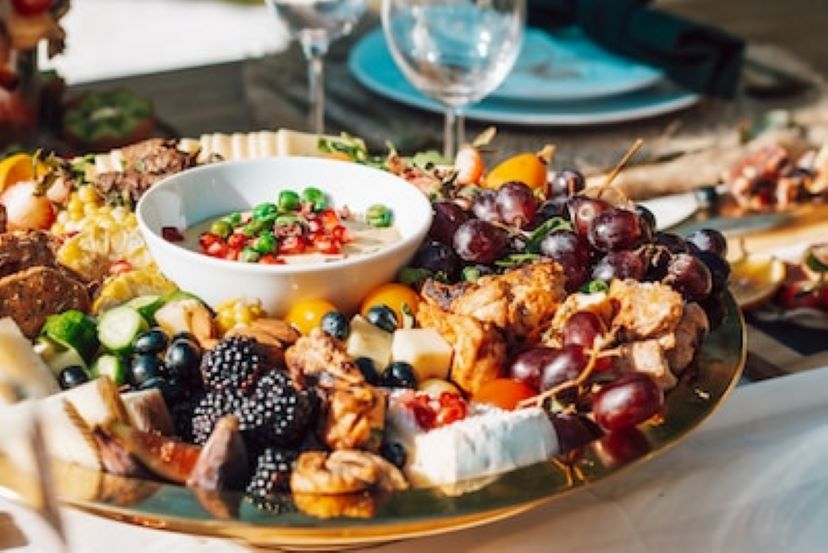Charcuterie Board Set
When it comes to hosting gatherings or indulging in a delightful evening at home, there’s one culinary art form that never fails to impress – the charcuterie board. A beautifully arranged charcuterie board not only tantalizes the taste buds but also serves as a visual masterpiece that can be the centerpiece of any occasion. To embark on this culinary journey with confidence and flair, you need the right tools. In this article, I’ll guide you through the world of charcuterie board sets, sharing my top recommendations available on Amazon. Whether you’re a seasoned entertainer or a novice looking to impress, these sets are your ticket to creating charcuterie magic.
History of The Charcuterie Board Set
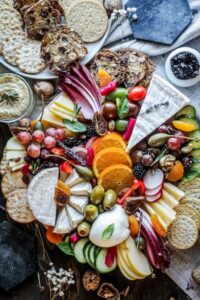 Let’s embark on a journey through time to uncover the fascinating history of the charcuterie board set. This culinary tradition, which now graces our tables with its delicious delights and elegant presentations, has a rich and diverse heritage.
Let’s embark on a journey through time to uncover the fascinating history of the charcuterie board set. This culinary tradition, which now graces our tables with its delicious delights and elegant presentations, has a rich and diverse heritage.
The term “charcuterie” itself originates from the French word “chair cuit,” which translates to “cooked flesh.” It’s a fitting beginning for a tradition rooted in the art of preserving and presenting meats. The history of charcuterie dates back to ancient civilizations, where the need to preserve meat led to innovative techniques.
Ancient Beginnings
Let’s take a captivating journey back in time to ancient Egypt, Greece, and Rome, where the foundations of the modern charcuterie board set were laid. In these ancient civilizations, resourcefulness met culinary ingenuity as people discovered innovative ways to preserve meats and elevate their flavors.
A Preservation Odyssey
In the scorching sands of ancient Egypt, where the bounty of the Nile River thrived, people recognized the need to make their meat supplies last longer. They turned to the art of salting, a technique that involved coating meats in a generous layer of salt. This not only acted as a preservative but also added a distinctive savory flavor. Imagine the satisfaction of savoring a piece of salt-preserved meat by the banks of the Nile.
Across the Mediterranean in ancient Greece, a different method of meat preservation emerged – smoking. The Greeks ingeniously used smoke to both deter pests and impart a smoky, aromatic essence to their meats. These smoked delicacies were cherished not only for their longevity but also for the unique depth of flavor they possessed.
Meanwhile, in the mighty Roman Empire, where extravagant banquets were the hallmark of opulence, meats took center stage. Cured and salted meats adorned platters, enticing the senses of those fortunate enough to attend these grand feasts. The bustling Roman banquets, replete with platters of salted and cured meats, were, in many ways, a precursor to the charcuterie spreads we cherish today.
A Culinary Heritage Preserved
The ancient techniques of salting, smoking, and drying meats served a practical purpose – the preservation of precious 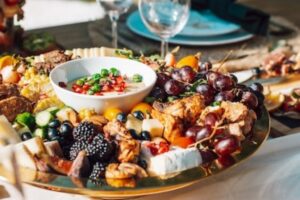 sustenance. Yet, they did much more than that. They elevated the flavors, turning simple meats into savory treasures that delighted palates and brought people together in celebration.
sustenance. Yet, they did much more than that. They elevated the flavors, turning simple meats into savory treasures that delighted palates and brought people together in celebration.
Fast forward to the present day, and we find ourselves still entranced by the legacy of these ancient culinary innovators. The charcuterie board set, with its assortment of cured meats, cheeses, and accompaniments, pays homage to these age-old preservation methods. It allows us to recreate the essence of those ancient feasts, where the marriage of preservation and flavor enhancement gave birth to culinary delights that transcended time.
So, the next time you arrange a charcuterie board, think of it as not just a delightful spread of flavors but also as a tribute to the resourcefulness and culinary genius of those who came before us. The charcuterie board set, with its exquisite combination of tastes and textures, is a living testament to the enduring appeal of flavors that have been cherished for centuries.
The European Renaissance – A Culinary Revival
Now, let’s fast forward to a period of remarkable cultural and culinary rebirth – the European Renaissance. This pivotal era marked the resurgence of arts, sciences, and yes, the fine art of charcuterie. In the bustling streets of France and Italy, a new culinary maestro emerged – the charcutier, a skilled artisan with a profound mastery of preparing and preserving meats.
As the Renaissance swept across Europe, the demand for exquisite flavors and culinary sophistication soared. People no longer viewed meats as mere sustenance but as canvases for culinary creativity. Charcuterie, or specialized shops dedicated to crafting these delectable creations, began to grace the city streets. These establishments became hubs of innovation, where skilled charcuterie experimented with curing, smoking, and seasoning to transform meats into flavorful works of art.
It was during this vibrant era that the foundations of the modern charcuterie board began to take shape. The Renaissance charcuterie, with their dedication to craftsmanship and a deep reverence for the culinary arts, sought to elevate the presentation of their delectable creations. They recognized that it wasn’t enough for these flavorful treasures to simply grace a platter; they deserved a stage befitting their magnificence.
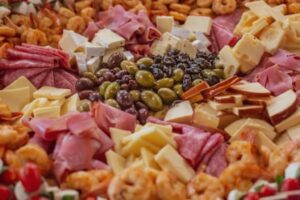 These visionary charcuterie started crafting wooden platters, often adorned with intricate designs and bearing family crests. These platters were more than mere serving vessels; they were pieces of art that showcased the culinary marvels within. With the emergence of charcuterie boards, the act of savoring cured meats and cheeses became a multi sensory experience, a celebration of flavors, textures, and aesthetics.
These visionary charcuterie started crafting wooden platters, often adorned with intricate designs and bearing family crests. These platters were more than mere serving vessels; they were pieces of art that showcased the culinary marvels within. With the emergence of charcuterie boards, the act of savoring cured meats and cheeses became a multi sensory experience, a celebration of flavors, textures, and aesthetics.
So, it was during the European Renaissance, amidst a flourishing of culture and culinary innovation, that charcuterie boards as we know them today took their initial form. These boards were more than just a vessel for food; they became an embodiment of the Renaissance spirit – a fusion of artistry and gastronomy. This tradition has transcended centuries, and today, we continue to honor this legacy by indulging in the delightful art of the charcuterie board, where flavors and presentation intertwine to create a truly memorable culinary experience.
A Feast for the Senses
Charcuterie boards weren’t merely about sustenance; they were a feast for the senses. Elaborate presentations of cured meats, cheeses, and condiments became a symbol of opulence and culinary mastery. The boards themselves evolved from simple wooden platters to works of art, often carved with intricate designs or bearing the family crest.
The Modern Resurgence
Charcuterie popularity waned and waxed over the centuries, but in recent years, it has experienced a remarkable resurgence. In an era where artisanal craftsmanship and culinary exploration are celebrated, the charcuterie board has once again taken center stage. Home chefs and entertainers alike have embraced this tradition, elevating it to new heights.
Today’s Charcuterie Board Sets
Today, charcuterie board sets come in an array of materials, from classic wood to sleek marble and eco-friendly 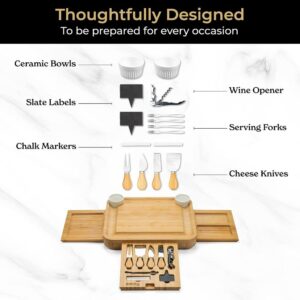 bamboo. They often include not just the board but also specialized knives and sometimes, additional accessories like ceramic bowls for condiments. These sets are designed to make the process of assembling and serving a charcuterie board both effortless and aesthetically pleasing.
bamboo. They often include not just the board but also specialized knives and sometimes, additional accessories like ceramic bowls for condiments. These sets are designed to make the process of assembling and serving a charcuterie board both effortless and aesthetically pleasing.
In conclusion, the history of the charcuterie board set is a testament to the enduring appeal of artful presentation and the celebration of culinary traditions. From its humble beginnings in preserving meats to its resurgence as a symbol of sophistication, the charcuterie board has captured our imaginations and taste buds throughout history. It continues to be a beloved tradition that brings people together to savor the finest flavors and create unforgettable moments. So, the next time you arrange an exquisite charcuterie board, remember that you’re not just serving food; you’re carrying on a culinary legacy that spans centuries.
What Is a Charcuterie Board Set?
Before we dive into the product recommendations, let’s ensure everyone is on the same page. A charcuterie board set typically includes a selection of boards or platters, knives or utensils, and sometimes, additional accessories. These sets are designed to make the process of assembling and serving a charcuterie board both effortless and aesthetically pleasing.
1. Bamboo Charcuterie Board Set
If you’re seeking an eco-friendly option that exudes rustic charm, the Bamboo Charcuterie Board Set is an excellent choice. This set often includes a large bamboo board, cheese knives, and even ceramic bowls for condiments. Bamboo is not only sustainable but also an ideal surface for serving cheese, cured meats, and other charcuterie delights. Its natural beauty complements the colors and textures of your food, making it a visually appealing choice.
2. Marble and Wood Charcuterie Board Set
For an elegant and sophisticated presentation, consider the Marble and Wood Charcuterie Board Set. These sets typically feature a marble slab paired with wooden accents. Marble provides an excellent surface for serving cold cuts and cheeses as it stays cool, while the wooden elements add warmth and character to the presentation. It’s a harmonious blend of aesthetics and functionality.
3. Slate Charcuterie Board Set
If you appreciate a touch of drama in your presentation, the Slate Charcuterie Board Set should be on your radar. Slate boards offer a striking backdrop for your charcuterie creations. They’re easy to label with chalk, allowing you to identify different cheeses and meats artistically. This set often includes specialized cheese knives and chalk for labeling, making it a fantastic choice for those who love to get creative with their presentations.
4. Acacia Wood Charcuterie Board Set
Acacia wood is known for its durability and rich, warm color. The Acacia Wood Charcuterie Board Set often features a generously sized board with grooves for crackers and small compartments for olives or nuts. The beauty of acacia wood lies in its natural grain patterns, which add a touch of elegance to your charcuterie spread. This set is both functional and visually appealing.
5. Cheese Board and Knife Set
If you’re primarily focused on cheese presentations, a dedicated Cheese Board and Knife Set is an excellent choice. 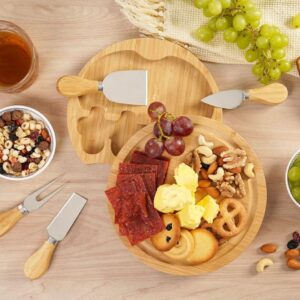 These sets often include a cheese board with specialized cheese knives designed for different types of cheese. Some even come with helpful guides on which knife to use for specific cheeses, making it an ideal option for cheese enthusiasts.
These sets often include a cheese board with specialized cheese knives designed for different types of cheese. Some even come with helpful guides on which knife to use for specific cheeses, making it an ideal option for cheese enthusiasts.
Conclusion
A charcuterie board set is more than just a collection of tools; it’s your key to crafting memorable culinary experiences. Whether you prefer the rustic appeal of bamboo, the elegance of marble and wood, the drama of slate, the durability of acacia wood, or a specialized cheese board set, there’s an option to suit your style and needs. Elevate your gatherings, impress your guests, and embark on a culinary adventure with the right charcuterie board set. The world of flavors and presentation possibilities awaits your creative touch.
Frequently Asked Questions (FAQs)
(Q) Can I use my charcuterie board set for other types of food presentations? (A)Absolutely! Charcuterie board sets are versatile and can be used for serving various appetizers, snacks, or even desserts.
(Q) Do these sets require special care and maintenance? (A) While care instructions may vary, most charcuterie board sets benefit from regular cleaning with mild soap and warm water. Some wooden boards may benefit from occasional oiling to maintain their luster.
(Q) Can I put these boards in the dishwasher? (A) It’s generally recommended to hand wash your charcuterie boards and accessories to prolong their lifespan. Dishwashing may cause damage or fading.
(Q) How do I prevent staining on marble or wood boards? (A) To prevent staining, avoid placing very oily or strongly colored foods directly on the board. For marble boards, cleaning up acidic spills promptly is also advisable.
(Q) Can I purchase additional accessories for my charcuterie board set?(A)Yes, many retailers offer additional accessories such as extra cheese knives, condiment bowls, or chalk for labeling. These can enhance your charcuterie presentation.
